In Zoom and other screen sharing applications, those gray boxes you sometimes see floating on…
Engagement Tips: Hosting an effective Q&A session
As you work to improve the quality of your webinars, the topic of engagement will come up constantly. Engagement can be defined and achieved in various ways. Most simply, webinar engagement is defined as the participant’s involvement or partaking in the event – their level of participation.
One of the most definite ways to encourage greater engagement is to host a question and answer or Q&A session during your webinar. An effective Q&A will also help you to establish your expertise with your audience.
Use these tips to make sure that you are maximizing engagement by implementing a highly effective Q&A session.
State how questions will be handled
Set the expectation early that you plan to have an interactive event that includes time for Q&A and present this clearly in your agenda. Explain how Q&A will work and whether questions will be typed in, verbal or both. Give some basic instructions, keep it brief and then get right into your content.
Prepare for expected questions
Work out three to five “canned” questions that you expect to receive or definitely want to answer. Not only will this help you to prepare for the questions that you anticipate taking, it will give you something to work from while attendees submit more questions and avoid any dead air during your Q&A.
Don’t wait until the end
People can only absorb so much information over a span of time. Though opinions vary on how long that attention span may be (consider this article on effective keynotes or take a more clinical dive into this pdf from physiology.org), stopping regularly for interaction and engagement points allows your participants to reset and get ready to absorb more. Segment your presentation in sections of 5-20 minutes in length with time for questions between those sections. If you have not taken any questions yet, use the canned questions that you have prepared, making sure they are relevant to the topics covered so far. As soon as you start answering questions, more questions will start pouring in which will help you to have a pool of excellent questions to choose from throughout the rest of your event. Set up a question that perfectly segues into your next section; that’s expert speaking at its finest.
Personalize your responses
When answering a question, state the first name of the asker. In rare situations, where attendees may know one another, you might use last names as well, but take caution with preserving attendee privacy. Start: “Here’s a question from Jane.” End: “Thank you for your question, Jane. Please follow up with any new questions.” This will let people know that you are really doing this live and give folks that warm, fuzzy feeling of receiving your direct attention.
Provide brief responses that are on topic
You’ll want to avoid drifting into a tangent or going off topic. If a question requires more than a few minutes of response, address the question as succinctly as possible and advise that you are happy to go further into the topic offline and continue the conversation. You can also use questions like this to help craft future presentations.
Address the most relevant questions first
Questions are bound to go outside of the scope of your presentation. Let your audience know that you are addressing as many questions as you can and that you may reach out after to close the loop on some questions that were left unanswered – again, continue the conversation offline. This will leave your audience with a positive impression of you and show your expertise while avoiding off-topic tangents.
End on time, but be willing go overtime
If you’ve reached the end of the time you’ve allotted for your event, it’s time to go through your closing remarks, thank your participants and co-presenters and wrap it up on time. If you have taken a ton of questions and want to stay on a bit longer to answer more questions, go for it; “We’re going to stay on a bit longer to answer some more of the many questions we’ve received today. Please stay with us if you are able.” This lets your audience know that you are conscious of and courteous to their busy schedules and that you are willing to go the extra mile to make sure that they get the answers they’ve waited so patiently for.
Take verbal questions
Verbal questions take engagement to a new level of personalization and satisfaction. While I highly encourage verbal questions and letting attendees join the conversation, there is a lot of caution to heed and organization around the process required. I’ll dive into this further in another post.
Use an expert producer and moderator to stay organized
Having a producer behind the scenes to work through the questions you receive will help you to stay on topic with the most relevant questions. The producer can respond to common questions easily and get them out of the queue: Are you recording? Can I have a copy of the slides? How do we get in touch with you? A strong moderator will help to set the stage for the presentation with a great introduction, guide the group smoothly through the Q&A portion and close the session with confidence. Also, the moderator’s voice can be crucial to breaking up the potential monotony of the presentation and pull your audience back in for more learning.
I know, this may be a lot to take in and implement right away, but following these crucial steps will vastly benefit your webinar and attendees.
If you want to do more to amplify your online events, we’re here to help. Schedule a free consultation or reach out and let’s do something great together.




